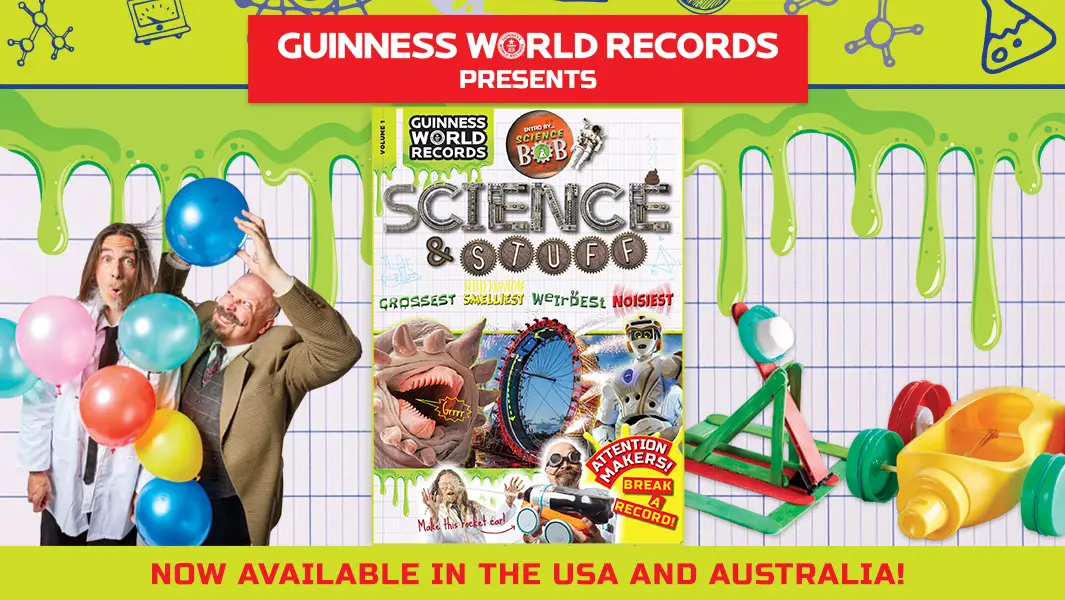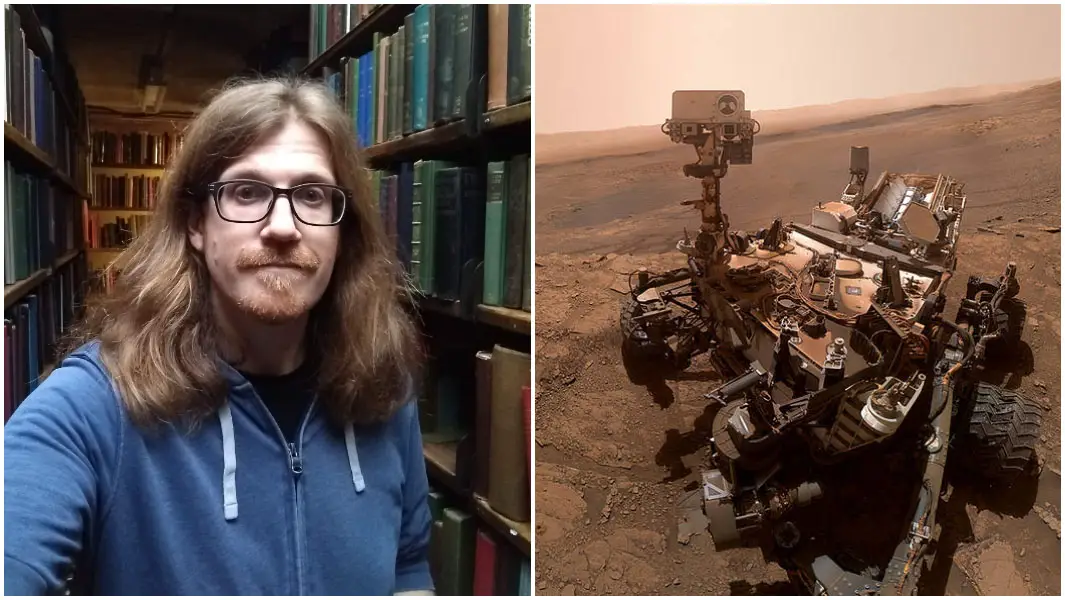


We’ll admit it, the Guinness World Records book can be a bit random!
One minute you’re reading about astronauts and the next you’re learning all about the world’s most venomous animals - but that’s the great thing about GWR.
And it’s perfect for Senior Editor Ben Hollingum, who says he’s always been interested in “everything all at once”. Basically, this job is right up his street.
Taking us Behind the Scenes of his work on the annual book, Ben admits you’ll most likely find him in the library, surrounded by old books and mountains of research.

The self-confessed history nerd loves nothing more than a deep dive into our archive, finding out exactly how those record-breaking moments in time came to be.
He said: “I’ve always been interested in a really broad range of subjects, and at Guinness World Records, I can usually indulge this without anyone getting mad at me because I’ve gone off on a tangent.
“No one looks twice if I go off to the library to research pre-war golf records, and come back with a big book on 1920s sideshow performers and another on a 1930s health fad that involved eating radioactive material. Those topics are all related, by the way. One day I’ll get around to explaining how.”
Ben works alongside Editor-in-Chief Craig Glenday, Managing Editor Adam Millward, and the rest of our brilliant book team to hand-pick the content every year.

He’s been doing it since 2015, and has certainly made his mark.
He explained how the team divide the book up depending on their areas of expertise, with Ben being the man for the job when it comes to technology, science and history.
Ben also enlists the help of experts from around the globe – like folklore lecturer Dr Ceri Houlbrook – bringing them on board to dig up interesting new records.
He said: “I generally do the records that require lots of paper research or badgering very intelligent and qualified people with questions.”
And Ben admits he can easily fall down the rabbit hole when he’s researching something, often writing thousands of words on a subject that he later has to edit down to just a couple of paragraphs for the book, because let’s face it, we’ve got an awful lot to fit within those pages!
“I’d definitely say I’ve got an obsessive personality,” Ben admits. “I tend to just keep going and going.
“Some of the records we come across can be a bit vague, but they shouldn’t be, and I find I can’t rest until I find out the exact facts about something.
“For example, there were some people at NASA who were very patient with me. They break a lot of records, so they get a lot of questions. The official write-up for the Curiosity Rover said it was ‘about 2.7 m (8ft 10 in) long’ and I thought, ‘you machined this thing in a lab, you must know exactly how long it is’. After a few emails, they came back to me with the exact measurement.
“I was satisfied after that.”
The Curiosity Rover on Mars holds a string of records, including the first selfie on another planet and the greatest elevation gained by a space rover with 621 m (2,037 ft 4 in), and for those wondering, its exact length is 2,769.07 mm.
Despite admitting he’s interested in everything, Ben must have a favourite subject to research, right?
“Well, that changes from year to year,” Ben said. “I tend to get really interested in whatever I’m working on, even when it’s something that even I thought would be dull. But the records that I always enjoy the most are the ones that have never been broken simply because the world moved on and the historic circumstances that made someone do something record-breaking in this way are no longer there.
“So, things like largest airship, no one really makes those anymore, or the most powerful steam locomotive. There are also titles like most aeroplanes flown, which were made possible by a unique set of historic circumstances.

“These records are a snapshot of a period of time.
“I also really like records that were broken by people who weren’t intentionally trying to break them. That’s why I like all the scientific stuff. You’ll contact someone and say to them, ‘you know this is the biggest… whatever’ and they’ll say ‘oh, is it?’ The record-breaking was incidental to what they were trying to do – probably something more important – and I like that.”
Ben is particularly fond of the incredible stories that can be found behind records, that is, if you’re willing to dig deep enough.
He said: “One example is the first photograph of a snowflake. It seems like quite a simple record on the surface, but the story is really fascinating.
“It was taken by a man called Wilson Bentley who was a farmer in rural Vermont in the late 19th Century. He’d grown up fascinated by the natural world, but didn’t find his true love until he turned 15 and his mother gave him an old microscope.

“After putting all sorts of things under the lens, he discovered snowflakes. He’d sit in a freezing barn and sketch them because he thought they were the most amazing, beautiful things.”
Ben continued: “He went on to build this crazy apparatus with a big bellows camera in an ice-cold barn because he wanted to preserve what he saw. After a few years of trying, he eventually managed to get it right and went to academics to say, ‘look I’ve got photographs of snowflakes’.
“They thought he was joking at first, but they quickly realized that he was the most amazing authority on snow and weather because he wrote obsessive notes about everything.
“He’d take a photo of a snowflake and then note down things like, ‘this fell from the leading edge of a eastward-heading storm, temperature was this, pressure was that’. He could guess what the snowflakes would look like by checking the weather.
“It wasn’t just scientific curiosity though, above all he simply thought snowflakes were beautiful. He would wax lyrical about how perfect they were, and he was content with his work. It’s just a lovely story.”

Another favourite record that Ben found in the GWR archives is that of the greatest distance covered by a runaway train – 97 miles (156 km) by a set of eight boxcars filled with coal set in motion by a storm in Akron, Colorado in 1884.
Ben said: “I saw this old record but there was only a one-sentence entry in our database, and when I saw the distance I thought it couldn’t possibly be true. I went to the newspaper archives because I had many questions.
“I searched through Great Plains newspapers though, and there it was – a story about a tornado in Colorado that set a coal train rolling downhill all the way into Nebraska. It even ended with a high-speed chase, with the runaway boxcars being pursued down the Republican River valley by a group of guys in a speeding locomotive.”
When it comes to researching records for the book, Ben has a strict rule, he won’t finish his work until he has at least a rough working understanding of what it all means.
He explained: “We often find ourselves with reams and reams of information, full of very specific terminology that only really makes sense to people in that field. This causes problems when we’re tasked with editing it down to 60 words for the book. And when those 60 words need to make sense to someone who isn’t, say, a toxicologist.

“I really enjoy the challenge of trying to explain complicated things in as few words as possible.
“There are a few draft records that are still sitting on my desktop because I’m not entirely sure I understand the cause-and-effect of what’s going on. Some of them, particularly the ones involving esoteric physics experiments, have been there for some time.”
And while Ben sounds like the exact person you want on your pub quiz team, there aren’t many places you’ll be able to go.
“I’ve been barred from quite a lot of pub quizzes,” he admitted. “I used to go every week with Craig [Glenday, Editor-in-Chief] and Adam [Millward, Managing Editor], but we started getting a lot of dirty looks for knowing some really unlikely stuff.”
Our book originally started as a way to settle pub arguments, but landlords probably weren’t expecting the editors to turn up to the weekly quiz!
Want more? Follow us across our social media channels to stay up-to-date with all things Guinness World Records! You can find us on Facebook, Twitter, Instagram, TikTok, LinkedIn, and Snapchat Discover– including our new Guinness World Records Extreme channel.
Don’t forget, we’re also on YouTube!
Still not had enough? Follow the link here to buy our latest book, filled to the brim with stories about our amazing record breakers.